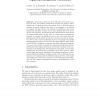Free Online Productivity Tools
i2Speak
i2Symbol
i2OCR
iTex2Img
iWeb2Print
iWeb2Shot
i2Type
iPdf2Split
iPdf2Merge
i2Bopomofo
i2Arabic
i2Style
i2Image
i2PDF
iLatex2Rtf
Sci2ools
IPMI
2003
Springer
2003
Springer
Ideal-Observer Performance under Signal and Background Uncertainty
We use the performance of the Bayesian ideal observer as a figure of merit for hardware optimization because this observer makes optimal use of signal-detection information. Due to the high dimensionality of certain integrals that need to be evaluated, it is difficult to compute the ideal observer test statistic, the likelihood ratio, when background variability is taken into account. Methods have been developed in our laboratory for performing this computation for fixed signals in random backgrounds. In this work, we extend these computational methods to compute the likelihood ratio in the case where both the backgrounds and the signals are random with known statistical properties. We are able to write the likelihood ratio as an integral over possible backgrounds and signals, and we have developed Markov-chain Monte Carlo (MCMC) techniques to estimate these high-dimensional integrals. We can use these results to quantify the degradation of the ideal-observer performance when signal ...
| Added | 07 Jul 2010 |
| Updated | 07 Jul 2010 |
| Type | Conference |
| Year | 2003 |
| Where | IPMI |
| Authors | Subok Park, Matthew A. Kupinski, Eric Clarkson, Harrison H. Barrett |
Comments (0)

